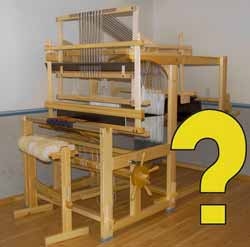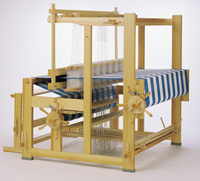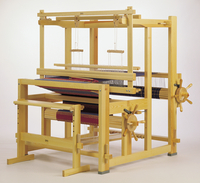Drawloom FAQs
What is a drawloom?

A drawloom is used to weave many different kinds of items and it is capable of weaving complex patterns. You can weave your name on a place mat, weave flowers on a wall hanging or weave images which can be designed as you would design a tapestry. The drawloom makes this possible by having two sets of shafts. These sets of shafts are called harnesses. So, a drawloom is a two harness loom. A drawloom is made by adding a drawloom bridge on to the top of a floor loom. A loom extension is added to the back of the loom to increase the depth of the loom. The shafts on the loom make the first harness of shafts. A second harness of pattern shafts is placed inside the loom behind the first harness of shafts. The second harness is used to produce patterns which cannot be made on an ordinary loom. There is a description of what a drawloom can do in another section of the web site, LEARN DRAWLOOMS.
If I set up a drawloom, can I use this loom for weaving other things?
Yes, you can weave on your loom after you have been using it as a drawloom. The drawloom bridge is easy to remove so the loom can be used for other weaving. And if you choose, the drawloom bridge can stay on the loom. The only part that has to come off is the second harness of pattern shafts. And you may be able to move the shafts to the side of the loom and let them stay there. They would not be in the way of the new warp unless you want to weave the full width of the loom or if you have a lot of pattern shafts in the loom.
You can leave the loom extension on the loom and it can be shortened to it's shortest setting. Or, you can leave it extended and put on longer beam cords, so that the tie-on bar will come all the way to the shafts when you are at the end of a warp.
What types of drawlooms are available?
There are two main types of drawlooms, the shaft drawloom and the single unit drawloom. You can also have a combination of these two types.
What is a shaft drawloom?
The shaft drawloom makes repeat patterns. Behind the shafts of the loom, a second harness holds the pattern shafts. Wooden handles for raising the pattern shafts are placed above the beater on the loom. These handles are attached to cords which go over the top of the drawloom frame, or bridge. When the handles are pulled, shafts in the second harness rise to make a pattern shed. The front harness of shafts, called the ground weave shafts, usually has from 4 to 8 shafts and the second harness can have up to 50 shafts. You can read about weaving damask and opphamta in Lillemor Johansson's book Damask and Opphamta. This book shows the older styles of drawlooms, gives recent history of looms and damask weavers, gives many patterns and shows how the patterns are woven.
What is a harnesk or single unit drawloom?
The single unit drawloom is made for weaving patterns which do not have a pattern repeat. Designs are made by pulling drawcords which raise individual units of heddles. The cords are held in place by wooden dowels located just above the beater. The new single unit drawloom is comfortable to use, with drawcords at eye level. This new system came about from the requests from the weavers to have the drawcords directly in front of the weaver. It is a smaller frame compared to the shaft drawloom. An older model of the single unit drawloom with an overhead beam is not as common. It has the capability of saving patterns, but it is a more complex drawloom. You can see photos of the older styles of drawlooms in the photos in Lillemor Johanssons book, Damask and Opphamta.
How are the drawcords made?
Texsolv drawcords come in black and white and are specifically made for the drawloom. They come in black and white to make selecting them easier, as you can easily find the cords you need to pull.
I have a Myrehed shaft drawloom. What do I need to order to make it a single unit drawloom?
If you have a Standard loom, you can easily add the combo, which will add the single unit drawloom to your shaft drawloom. If you have an older Glimakra drawloom, please send photos so that we can identify what you have. List what parts you already have, such as heddles, weights, shaft bars and cord, to eliminate duplication. If you have a loom extension, the newer complete loom extension needs to be used. Contact us and we will tell you more about what you can add to your loom.
What is a combination drawloom?
The combination drawloom is a combination of the shaft drawloom and a single unit drawloom, all in one drawloom bridge. It requires having both the single unit drawcords and the draw handles for the shafts. You will need a vertical countermarch or you can use a counterbalance tie-up. The handles for raising the shafts sit right above the drawcords which raise individual units. With a combination drawloom you can weave designs such as a border across the weave using the shaft draw and then with the single unit, make a different pattern or make the border pattern up the sides of the fabric.
What kind of loom do I need if I order a drawloom?
Drawlooms can be fitted to most Swedish looms such as the Glimakra looms. If you have another kind of Swedish loom, let us know what the model is and we can determine if you can add a drawloom. If you have a loom other than a Swedish loom, it may be difficult to fit these drawlooms to your loom.
What size loom is required to make a drawloom?
The drawloom is designed for many weaving widths of the standard sized Swedish looms. The smallest weaving width is 100cm or 39.5 inches. The other sizes are 120cm or 47 inches, 150cm (59 inches) and the largest is 160cm (63 inches). The price list shows these four sizes only. If your loom has a discontinued weaving width, you will not see it on the price list. Contact us for getting a drawloom to fit your loom. The maximum height of a drawloom is 77 inches.
How many shafts does a loom need if a drawloom is added?
You can make a drawloom with a loom that has only four shafts, but if you want to weave satin, you will need 5 shafts. The 6 shaft satin is also very commonly used for damask weaving using finer threads. It is nice to have 6 to 8 treadles.
What is a loom extension and do I need one?
The loom extension gives added depth to the loom. This depth is needed to give space for the second harness of shafts and to give sufficient depth to make a good shed. The Standard loom depth is 56 inches. For weaving with 10 pattern shafts, you need to extend the loom about 20-24 more inches of depth. Long eyed heddles in the first harness reduce the size of the shed. This is compensated for my having longer heddles and greater loom depth. The new loom extension is an improvement over the older Glimakra extension as it has a “roof”, which is an aid for warping the loom and hanging the shafts.
How far does the loom extension extend beyond the original loom frame?
The loom extension is adjustable and can extend the loom a small distance, about 8 inches, to over one meter (3 1/2 feet). It is easily adjustable and when shortened, the frame of the extension fits inside the original loom frame. On the Standard loom, you need at least two feet of extra loom depth.
Can I use my old Glimakra loom extension if I order a drawloom?
The old Glimakra extension was not built up to full height. A new loom extension would be needed as the shaft drawloom bridge partly rests on the roof of the extension.” For those who order a new drawloom, you need to order the loom extension.
What countermarches are available?
There are two types of countermarches available, the horizontal, which has two horizontal jacks for each shaft and the vertical, which uses pulleys and one center jack for each shaft. You can see how these two types work by looking at diagrams in the Basic Loom Information file under Learning about Looms.
What are the advantages and disadvantages of horizontal or vertical countermarch?
- The horizontal countermarch is more common and is less expensive. With the horizontal countermarch, you have a cord running down the center of the warp to the lower lamms. This cord does not interfere with the weaving and it gives a very direct pull from the treadles. There is little friction on the cords.
- The vertical countermarch is taller then the horizontal countermarch by about 8 inches. It is about two inches taller than the beater on the loom. With the vertical countermarch, many of the cords pass over pulleys to go to the shafts and to the lamms. The cords to the lower lamms pass over pulleys and then down on the outside of the loom. So, this cord does not go down through the warp threads.
- It is easy to reach everything on the horizontal countermarch, but for the vertical countermarch, you may need to stand on a small stool to reach to the center to tie up vertical jacks at the top of the loom. However, these cords can be attached to the countermarch
before it is placed on top of the loom.
The countermarch you already have may be compatible with a drawloom. If you want to inquire, tell me what kind of loom you have, the weaving width and what type of countermarch and I will let you know if it is compatible. The Standard loom requires the vertical countermarch, but the Ideal and the 100cm Standard uses a horizontal countermarch. The single unit drawloom can in most cases, use a either countermarch.
How do I order a drawloom?
What equipment is necessary for a drawloom?
- The loom extension.
- The drawloom bridge. You need to choose between the shaft, single unit or large shaft bridge. Each will have a different drawloom bridge. The drawloom comes with accessories, except the heddles. The tie up cord included will tie up 30 pattern shafts.
If you don't have them, these will have to be ordered:
- Long eyed heddles and long pattern heddles
- Damask shuttles (or Swedish shuttles)
- Cord threader
What decisions do I need to make to put in a drawloom order?
Determine if you want a shaft, single unit or a combination drawloom. The large shaft drawloom has a larger bridge and can hold more than 50 pattern shafts.
If you have questions about drawlooms, you can email or call me.
When you determine what you want contact us to discuss the loom size, type of countermarch, number of heddles and any other loom accessories you may need.
How many drawloom shafts should I order?
Adding more drawloom shafts will give you more pattern possibilities. Lillemor Johanssons book Damask and Opphamta has patterns which show you what you can do with 10, 20 shafts and more. Which ever you choose, you can add to it. You can start with 10 shafts, there are many patterns that you will find. You can later add shafts 10 at a time, up to 50. If you think you will someday want more than 50, order the larger bridge that can have up to 100 shafts on the widest looms.
Where is the drawloom made?
Glimakra makes looms in sizes 100cm (39.5 inches) 120cm (47 inches), 150cm (59 inches) and 160cm (63 inches) which can have drawlooms added to their frames. Older models of Glimakra and Andersson looms can also have drawlooms added to them. The Myrehed drawlooms are made by the Myrehed family in Varmland Sweden.
What is the delivery time for a drawloom?
Drawlooms are usually in stock. It takes a couple days to pack the drawloom before it is sent. In the event that we don't have your loom size drawloom in stock, we will let you know how long it will take to get that size. Some drawlooms are sent by FedEx, others by truck.
What is included in the drawloom DVD?
The DVD demonstrates how a drawloom works, showing various types of drawloom, including the older models. Beaming the warp, threading the shafts and tying up the lamms and treadles is shown and is similar for all drawloom types. It is very helpful to follow the video when setting up a drawloom.
What is the cost of a drawloom?
- Please refer to the current price list.
- Drawlooms do not include the countermarch or the drawloom heddles.
- The single unit drawloom includes 200 heddle weights and 200 draw cords.
- The shaft drawloom includes 11 shafts, tie up cord and 200 weights on the small bridge and 21 shafts and 200 weights on the large bridge.
- Extra shafts include their handles.


